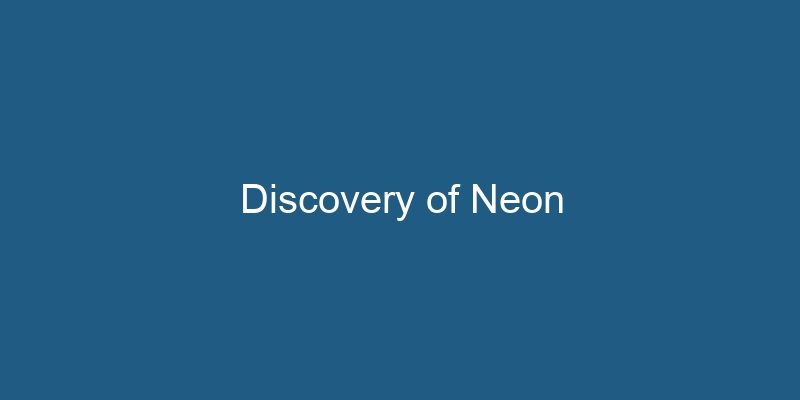Neon, a chemical element and a noble gas, was discovered in the late 19th century. This article will delve into the fascinating story of how neon was first identified and the subsequent developments that followed. Let’s explore the journey of this remarkable element.
- 1. Introduction
- 2. Early Observations
- 2.1 William Ramsay
- 2.1.1 Ramsay’s Experiment
- 3. Confirmation and Further Studies
- 3.1 Collaborations with Morris Travers
- 3.1.1 Spectral Lines
- 4. Recognition and Widespread Use
- 4.1 Neon Lights
- 4.1.1 Working Principle
- 5. Further Developments
- 5.1 Lasers
- 5.1.1 Laser Applications
- 5.2 Cryogenic Refrigeration
- 5.2.1 Superconductivity Research
- 6. Conclusion
1. Introduction
Neon, with the atomic number 10 and symbol Ne, belongs to the group of noble gases in the periodic table. It is colorless, odorless, and tasteless, making it a unique element. Neon is widely used in various applications, including neon lights, lasers, and cryogenic refrigeration. But how was neon actually discovered? Let’s find out.
2. Early Observations
In the early 19th century, scientists had already observed peculiar phenomena associated with certain gases. Sir Humphry Davy, an English chemist, observed a brilliant red glow when an electric current was passed through a sample of nitrogen gas. This phenomenon piqued the interest of many researchers, including William Ramsay.
2.1 William Ramsay
William Ramsay, a Scottish chemist, became intrigued by the unique properties of gases and set out to investigate further. His experiments led to the discovery of several noble gases, including neon. Ramsay hypothesized that there might be other gases in the atmosphere besides the commonly known ones.
2.1.1 Ramsay’s Experiment
Ramsay conducted a series of experiments using a method known as fractional distillation. He cooled atmospheric air until it liquefied and then slowly allowed different gases to evaporate at different temperatures. By doing so, he separated the components of air and identified various gases, including neon.
2.1.1.1 Isolation of Neon
After the fractional distillation process, Ramsay observed a reddish glow in one of the gas samples. This glow indicated the presence of a previously unknown gas, which he named neon derived from the Greek word “neos” meaning new. Ramsay had successfully isolated neon, marking a significant milestone in the understanding of gases.
3. Confirmation and Further Studies
Ramsay’s discovery of neon was groundbreaking, but further studies were needed to confirm its properties and characteristics. Other scientists joined the efforts to explore this newfound element, leading to significant advancements in our knowledge of neon.
3.1 Collaborations with Morris Travers
Morris Travers, a British chemist, collaborated with Ramsay to conduct additional research on neon. Together, they studied the spectral lines emitted by neon gas when subjected to electric discharges. This analysis allowed them to confirm the presence of neon and determine its atomic spectrum.
3.1.1 Spectral Lines
By passing an electric current through neon gas and observing the resulting spectrum, Ramsay and Travers identified distinct spectral lines specific to neon. This confirmed its unique atomic structure and further solidified its classification as a noble gas.
4. Recognition and Widespread Use
Following the discovery and confirmation of neon, it gained recognition among the scientific community. The unique properties of neon, such as its ability to emit vibrant colors when electrically charged, led to its widespread use in various applications.
4.1 Neon Lights
One of the earliest and most iconic uses of neon is in neon lights. Georges Claude, a French engineer, developed the first commercial neon light in 1910. These lights quickly gained popularity due to their vibrant and eye-catching glow, revolutionizing the advertising and signage industry.
4.1.1 Working Principle
Neon lights work based on the principle of electric discharge through neon gas. When a high voltage is applied to the gas-filled tubes, the electrons gain energy and transition to higher energy levels. As they return to their original energy level, they emit photons, creating the characteristic glow.
4.1.1.1 Neon Colors
Neon lights can emit different colors depending on the gas used and the presence of additional elements. Neon gas alone emits a reddish-orange color, while other noble gases mixed with fluorescent coatings produce different hues.
5. Further Developments
Since its discovery, neon has continued to play a significant role in various scientific and technological advancements. Let’s explore some of the notable developments that have occurred in the study and application of neon.
5.1 Lasers
Neon lasers have become an essential tool in scientific research, medical applications, and industry. They utilize the unique properties of neon gas to amplify light and generate intense laser beams.
5.1.1 Laser Applications
Neon lasers find applications in areas such as holography, barcode readers, and laser light shows. They are also used in medical procedures, such as retinal surgeries and skin treatments, due to their precise and controlled beam delivery.
5.2 Cryogenic Refrigeration
Neon, along with other noble gases, is used in cryogenic refrigeration systems. Its low boiling point and ability to cool rapidly make it ideal for cryogenic applications, such as superconductivity research and cryosurgery.
5.2.1 Superconductivity Research
Neon is employed to cool superconducting materials to extremely low temperatures, enabling scientists to study and harness the unique properties of these materials. This research has paved the way for advancements in fields like transportation, energy, and computing.
6. Conclusion
The discovery of neon and subsequent research have significantly contributed to our understanding of noble gases and their applications. From its identification by William Ramsay to the development of neon lights, lasers, and cryogenic systems, neon has left an indelible mark in science and technology. As we continue to explore the properties of neon and other elements, who knows what other remarkable discoveries lie ahead.

